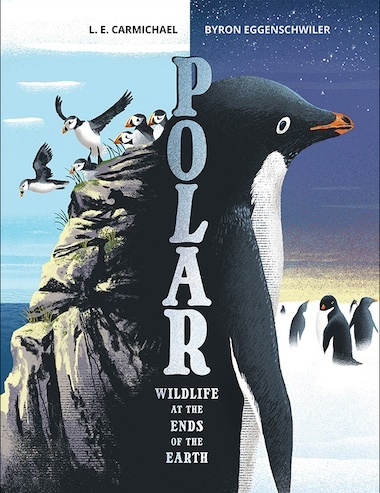L.E. Carmichael's Blog, page 3
March 8, 2025
A Battle Cry for International Women’s Day
Voices are noise, humanly noise—but what knows best in you is not of human shape or sound but of a stranger, wilder beast. Now it turns in your stomach, now it rends your chest. Tell the voices to shut up & listen for the growl.
Taisia Kitaiskaia, from Ask Baba Yaga
#IWD2025
March 1, 2025
Emily Deibert: Learning to Take My Shot

The cover of Bea Mullins Takes a Shot by Emily Deibert. Illustration by Isabelle Duffy and design by Jade Rector.
Welcome to Cantastic Authorpalooza, featuring posts by and about great Canadian children’s book creators! Today’s guest: Emily Deibert . Take it away, Emily!
Like many tweens, one of my biggest fears growing up was embarrassing myself. I was so scared of looking silly in front of my classmates that I often didn’t let myself try new things—from learning a new dance or musical instrument to playing a new sport. I’d decided that I was safer sticking to the sidelines and staying far, far out of the spotlight. The way I saw it, never trying anything new meant never even opening myself up to the possibility of embarrassing myself.
Given all that, it will probably come as a surprise to hear that in the 11th grade, I decided to join my school’s girls’ ice hockey team—despite never playing hockey before in my life! To this day, I’m still not entirely sure how I let my friends talk me into it. But the team really needed more players, because there weren’t many girls who played hockey at our school at that time—and I figured that if we were all beginners, I couldn’t embarrass myself too badly, right?
The closer we got to our first game, the more I started to think that maybe joining the team had been a huge mistake. And when we didn’t just lose that game, but got totally crushed by the opposing team, I was certain that I’d been right. The final score? 12-0! For a teen who was terrified of failure and embarrassing herself, that loss came as a pretty harsh blow.
Except when we got back to the locker room after the game ended, I was surprised to see that the rest of my teammates didn’t really mind that we’d lost—in fact, they were just happy that we’d gotten enough girls on the team to be able to play at all! It was then that I first realized that maybe sports don’t always have to be about winning, and that maybe losing a game—even by twelve-nothing—doesn’t have to be the most embarrassing thing in the world.

A photo of my high school girls’ hockey team, the Danforth Red Hawks. Photo courtesy of Emily Deibert.
Like myself when I was a tween, the protagonist in my debut middle grade novel Bea Mullins Takes a Shot is initially very reluctant when it comes to doing anything outside of her comfort zone—least of all joining her school’s first-ever girls’ ice hockey team! Bea hasn’t skated in years, and she’s not even sure she remembers how to stop on ice skates. And while her Dad and older brother may be big-time hockey fans, Bea’s never played a game of hockey in her life—and part of her wants to keep it that way, thank you very much.
But like my high school hockey team, Bea soon comes to find that her fellow players on the Glenwood Geese always have her back—even when she falls during practice and misses passes during their games. It may take her a while, but Bea eventually realizes how cool it is to be a part of her school’s first girls’ hockey team ever. Especially given how traditionally male-dominated ice hockey has been in the past.
Today, women’s ice hockey is more popular than ever. The Professional Women’s Hockey League had a record-breaking inaugural season last year, with three Canadian teams inspiring the next generation of young women athletes. Bea looks up to these players in the book, and I look up to them in real life. And while it may have been a difficult journey for them to get there, I’m sure they knew what Bea eventually learns in the book: you miss 100% of the shots you don’t take.
Bea Mullins Takes a Shot is available now from Random House Books for Young Readers.
February 27, 2025
25 Cool Facts About Polar Bears
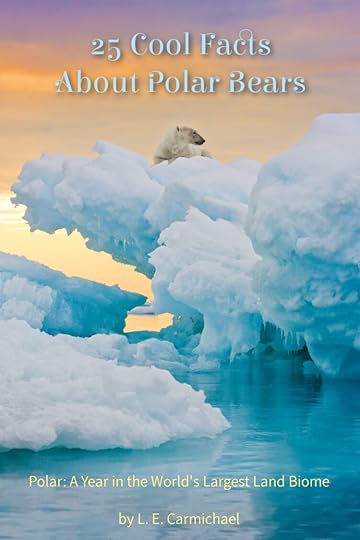 It’s International Polar Bear Day! Since it’s 2025, I’ve rounded up 25 cool facts about these icons of the Arctic, including a surprising discovery I helped make during in my former life as a wildlife geneticist. Is your favourite fact missing from this list? Feel free to add it in the comments!
It’s International Polar Bear Day! Since it’s 2025, I’ve rounded up 25 cool facts about these icons of the Arctic, including a surprising discovery I helped make during in my former life as a wildlife geneticist. Is your favourite fact missing from this list? Feel free to add it in the comments!
1) The polar bear’s closest relatives are brown bears — specifically, the ones living in Siberia.
2) Polar bears are terrestrial (land-based) animals that play a large role in marine (ocean) ecosystems. Marine biologists classify them as fissipeds (split foots) because, unlike true marine mammals with flippers, bears still have separated toes!
3) Polar bears can live up to 32 years.
4) Females weigh up to 700 pounds; males up to 1300.
5) Their paws are up to 30 cm wide, creating natural snowshoes that help spread their body weight over snow and ice.
Habitat6) Polar bears are sometimes found on multi-year ice (sea ice that stays frozen over the summer) but prefer “fresh” ice that forms each winter, because that’s where most of the seals are.
7) In areas where the ice melts in summer, bears move onto land.
8) Wrangel Island (off the northeast coast of Siberia) has the highest density of polar bear dens in the world.
Food9) While denning and raising her cubs, a female polar bear can go up to 8 months without food.
10) Ring seals are polar bears’ favourite food, but they will eat anything they can catch, including belugas and narwhals.
11) They don’t catch seals often! One study of polar bears in Svalbard estimated that seal hunts succeed less than 9 percent of the time.
12) Adult walruses are too big for most polar bears to catch. But on Wrangel Island, bears may rush beached walruses to create a stampede. The bears can then eat any animals that were injured in the panic.
13) Arctic foxes often follow polar bears, hoping to scavenge from the bear’s kills. It’s a dangerous strategy, as polar bears sometimes eat the foxes!
14) Polar bears have been found in the stomaches of Greenland sharks! Those sharks had also eaten a lot of species found on the sea floor, suggesting they scavenged on a polar bear carcass, rather than attacking a live bear.
Movement15) In 2006, a Greenpeace expedition spotted a polar bear within one mile of the North Pole! It was over 550 miles from the nearest land.
16) Scientists use radio collars to track the movements of female polar bears. One bear traveled from the Beaufort Sea in Alaska to Northern Greenland. In total, she travel 7162 km over 576 days.
17) Scientists can’t use radio or GPS collars to track male polar bears — their necks are thick and their skulls are narrow, so the collars slip right off!
Surprising Science18) Polar bear fur helps prevent the bear’s body heat from escaping into the cold Arctic air.
19) Polar bear hairs are full of microscopic pockets of air. Their fractal structure not only conserves body heat, it absorbs heat energy from the bear’s environment!
20) If a bear gets too hot, it jumps in the water to cool down. The origin of our polar bear swim, perhaps?
21) When I was a graduate student, bear biologists in Nunavut found a female polar bear whose private parts looked a little bit more like a male bear’s. In all the years they studied her, the bear never gave birth to a cub. I performed DNA testing on a sample of her blood and discovered she had at least part of a Y chromosome in her genome. This genetic anomaly might have been the reason that she was unable to reproduce.
Climate Change and Conservation22) There are between 22,000 and 31,000 polar bears world wide.
23) The International Union for the Conservation of Nature listed polar bears as Vulnerable in 2015. Species listed as Vulnerable could become Threatened or Endangered if we don’t do something to protect them.
24) The greatest threat polar bears face is the loss of Arctic sea ice due to ongoing climate change.
25) Another related threat is hybridization with brown (grizzly) bears, which are following warmer weather north into polar bear territory. Several hybrid bears have been documented — in the media, they’re often called pizzlies or grolar bears.
There are lots of things you can do to help protect polar bears, ranging from donating to conservation organizations to reducing your carbon footprint. You can even raise awareness by sharing your favourite polar bear facts on social media – use the official hashtags #InternationalPolarBearDay and #PolarBearDay
Want to know about other polar animals? Check out Polar: Wildlife at the Ends of the Earth, my multi-award-winning science book for ages 8-12. Teacher friends, Polar is a perfect companion to your lessons on habitat and adaptations. Available from Amazon, at chain bookstores, and through your local indie bookshop.
February 11, 2025
Tahrana Lovlin, Snow Specialist
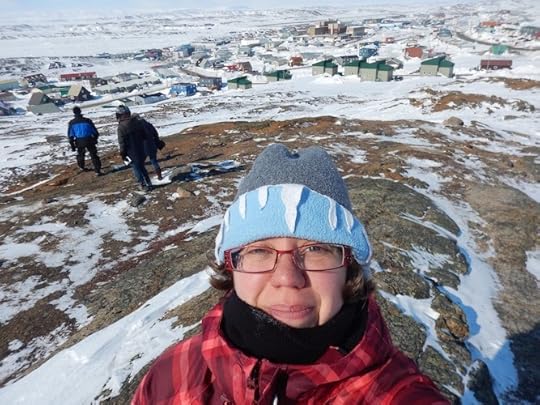 Happy International Day of Women and Girls in Science! I’d like you to meet a good friend of mine –
Tahrana Lovlin. She’s a brilliant woman and an accomplished engineer with an unusual specialty. Take it away, Tahrana!
Happy International Day of Women and Girls in Science! I’d like you to meet a good friend of mine –
Tahrana Lovlin. She’s a brilliant woman and an accomplished engineer with an unusual specialty. Take it away, Tahrana!
So I’m writing this because Lindsey asked me to and I’ve known her for almost 35 years (wow, crazy). And I’m an engineer. Not your stereotypical engineer, the ones you see in the movies that work for NASA and wear ties and carry pocket protectors. Those engineers don’t exist – well, not anymore. Or if they do, they are a small portion of the overall world of engineering. As an engineer, I problem solve with a team that requires daily communication and coordinating, I write A LOT of reports, and occasionally I get to go to cold places for work. I’ve helped on projects in Alaska, Northwest Territories, Nunavut, northern Labrador, and Antarctica.
I got a bachelor degree in Civil Engineering at the University of Waterloo in 2000. I did a year of structural design in Yellowknife, and then returned to southern Ontario to get married. I applied to a few design firms, but ended up at RWDI, a niche engineering consulting firm that did some pretty cool stuff according to the Discovery Channel.* I got a job there pretty much based on the fact I had “experience” with snow, meaning I had lived in the Northwest Territories for more than a decade. And since then, I have spent my career figuring out how wind and snow interact with buildings, and how this interaction affects pedestrians and users of the building. I now work for SLR Consulting in Guelph, Ontario.
So let’s talk snow, which is one of my favourite subjects. I like the way snow sounds, especially at -40C. I love the way it drifts into these perfect aerodynamic shapes that seem to defy gravity. It amazes me how much can accumulate in front of my garage after a good storm!
There are two facts about snow that are essential in my job. One fact is that snow only moves or “drifts” once the wind speed reaches about 20 km/h. Which means, if you consider the average winter wind speed, there is less chance of drifting snow in Inuvik (~ 8km/h) than in St John’s (~ 25 km/h). The second fact is that snow can only drift for about 3 km and then it rubs itself out; this is probably a good thing or there would be way more snow in Winnipeg than I would care to consider.
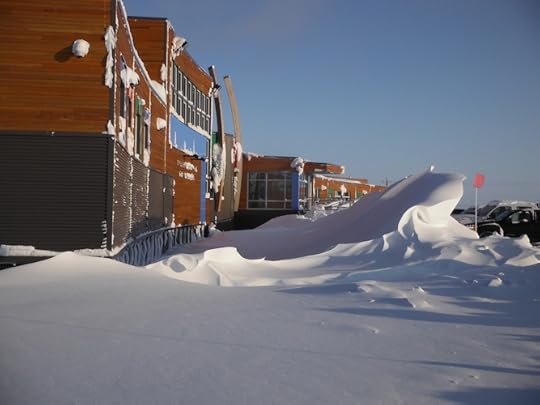
Now, if you put a building in the way of this wind and snow, the snow will only accumulate in sheltered areas where the winds speeds are calm, and would be scoured from areas with strong winds. If the building is square and on the ground, and the wind hit it perfectly perpendicular to the upwind side, the snow would form a horseshoe-shaped drift around three sides. Right against the building the ground would be scoured by the wind, but a few metres away from the building a 1 to 3 m tall drift would form. On the downwind side, the drift would form right against the building facade, and if there were enough snow, the downwind drift could be as tall as the building!
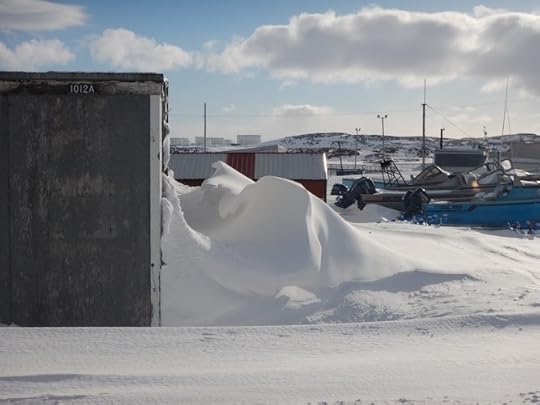
However, if you were to raise the building above the ground, as they do in the Canadian Arctic, the downwind drift would form away from the building. Where the drifts form can significantly impact the accessibility of the building in winter, and the effort required for snow removal, which affects the day to day life of people that use the building. Think of it, do you want to shovel out your front entrance every day or would you rather use the sustainable approach of having Mother Nature clear it for you? As a snow engineer, it’s my job to think of that stuff for you.
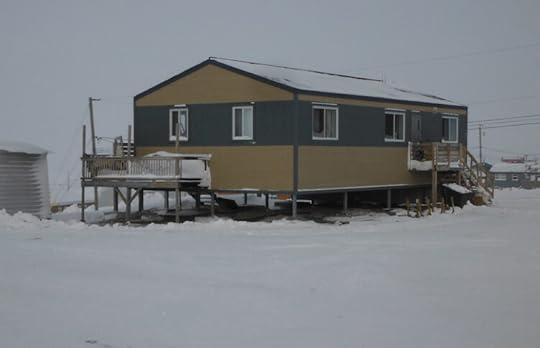
*I can vouch for that – some of RWDI’s work on the world’s tallest building appears in my teen book, Amazing Feats of Civil Engineering.
February 9, 2025
Elaine Kachala: Wearable Technologies Are Giving Us Superpowers—I’m Hopeful, but Also Worried
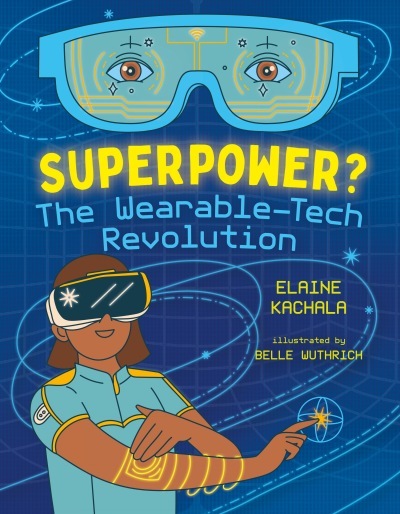 Welcome to Cantastic Authorpalooza, featuring posts by and about great Canadian children’s book creators! Today’s guest:
Elaine Kachala
. Take it away, Elaine!
Welcome to Cantastic Authorpalooza, featuring posts by and about great Canadian children’s book creators! Today’s guest:
Elaine Kachala
. Take it away, Elaine!
I was waist-deep in research about fourth industrial revolution technologies (4IR) when, many drafts later, I’d landed on the topic of wearables—technology that’s on, in, or attached to your body. The topic cast a spell on me. I had to think, why was I suddenly so invested? I realized two things: That deep down, this multifaceted topic had to do with health, well-being, and equity. These issues are close to my heart and at the core of my professional work. (I worked as a health policy researcher, advisor, and writer for over twenty years). And, beyond the blow-your-socks-off cool factor, our society faces many challenges with wearables and tech innovation. I didn’t see these issues reflected in books for young readers, yet kids have a significant role in helping steer the world toward a better future. That’s how the book, Superpower? The Wearable-Tech Revolution came to be!
Our brains, skin, eyes, ears, other body parts, and clothing are becoming the new ways we connect with technology. Immersive technologies like virtual reality (VR) and augmented reality (AR) offer exciting new ways to work, learn, and play. Robotic suits (exoskeletons) help soldiers and factory workers to carry heavy loads safely. And in health care, breakthrough research is happening on many fronts. For example, virtual reality (VR) reduces loneliness and improves brain health in older adults. Brain-computer interface (BCI) technology enables people with severe disabilities to move and communicate, and robotic suits allow people with disabilities to live fuller, more active, and more connected lives. The possibilities of wearables to improve our lives are limitless; these are just some examples.
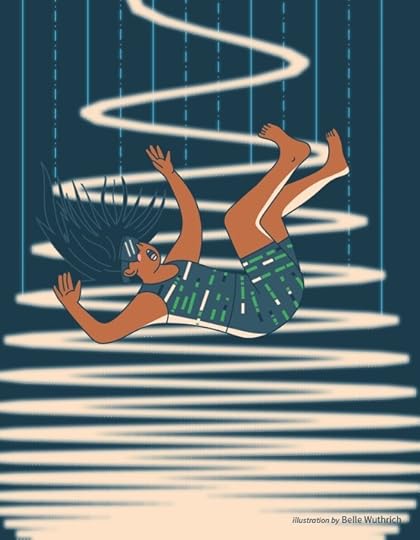 All good, right? Not exactly.
All good, right? Not exactly.
As I dug further into the research, I learned about many downsides to technology and innovation. Data privacy breaches, device safety and reliability problems were among the challenges. Even the idea that innovation can go too far, like with brain-computer technology that, might one day be able to read our minds. Experts are warning us about dangers.
I also learned about a “move fast and break things” culture that drives tech development. It means innovating fast, not worrying about how tech impacts people and being a disrupter. Experts now agree that this mindset is dangerous!
Then, there’s the issue of tech inequities; what if some people can access technology to help them and others can’t? The gap may increase as devices become smarter, faster, more precise, user-friendly and mainstream.
Or, what about the idea that not everyone believes we should spend billions augmenting our minds and bodies with technology? Some people with disabilities are speaking out about this. People see disability differently; people have different abilities. And not everyone with a disability wants to be “fixed.” Many just want a working wheelchair, a job, health care, accessible spaces, and not to be poor.
And let’s not forget about who the developers behind this technology are. When teams are diverse and inclusive, we have better, safer products. But are company policies and practices mindful of this fact? And do all kids have access to STEAM education and training? While some things are changing, there’s more to do to resolve injustices.
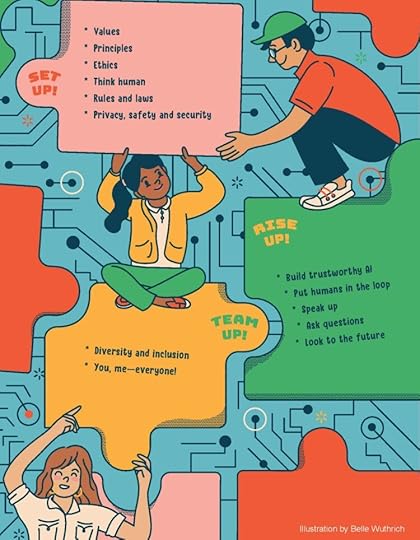
Enter the era of responsible design. For all the issues raised here and more, scientists, engineers, designers, and inventors of all kinds, including young inventors, are on a responsible design mission. They’re asking how can we innovate safely, fairly, and equitably? How do we reap the benefits of wearable technology while still protecting against harm?
 I hope this book sparks kids’ curiosity, expands their thinking about science and technology in society, and instills hope by showing how STEAM can help solve pressing problems. At the same time, I hope they consider how inventors have a big responsibility when developing technology.
I hope this book sparks kids’ curiosity, expands their thinking about science and technology in society, and instills hope by showing how STEAM can help solve pressing problems. At the same time, I hope they consider how inventors have a big responsibility when developing technology.
Superpower? The Wearable-Tech Revolution (Orca Book Publishers, 2022) is my debut book. I’m so excited that honors include Best STEM Book (NSTA/CBC, 2023), and a finalist for the AAAS/Subaru SB&F Prize for Excellence in Science Books (2024), the Red Cedar Book Award (2023-24) and SCBWI’s Golden Kite Award (2023). Readers can download a free Teacher’s Guide and resources from my website.
Thank you, Lindsey, for giving me the opportunity to share my book!
February 2, 2025
Watery Facts for World Wetlands Day
I collect information the way crows collect shiny things! Historically, this impulse to collect the weird and wonderful found expression in cabinets of curiosities: precursors of modern museums assembled by aristocrats, explorers, and early scientists. While I acknowledge the devastating context of colonialism* in which these cabinets were assembled, I share the deep sense of awe and wonder that motivated their creators. And so:
Welcome to my own cabinet of curiosities—facts, quotes, and oddments about pretty much everything!
Today’s Cabinet of Curiosities is in honour of World Wetlands Day. I did a lot of research on wetlands for The Boreal Forest, much of which simply would not fit in the book. Here are some favourite facts about these incredible habitats:
1. A LOT of different words are used to categorize wetlands, depending on which country you’re in. I’m partial to quagmire (which more or less means “quaking bog”) and strangmoor – a Scandinavian word that means “string bog.”
2. In Canada, there are two main types of boreal wetlands: fens and bogs.
3. Fens are connected to rivers, lakes, or groundwater.
4. Bogs are “cloud fed,” meaning all of the water in them comes directly from precipitation (mostly rain or snow). How much do I love the phrase “cloud fed?” So, so much.
5. Covering 372,000 square kilometers (almost 150,000 square miles), Canada’s Hudson Bay Lowlands are the second-largest boreal wetland in the world (the biggest one is in Russia).
6. Sphagnum moss loves to grow in boreal wetlands. This moss is a sponge, holding up to 4000 times its own weight in water!
7. In wetlands with deep moss layers, it can take decades for water to filter all the way through.
8. Sphagnum isn’t just spongey — it’s sticky! The moss binds minerals, like phosphorus, and poisons, like mercury. In other words, water coming out of a fen is cleaner than the water going in. Washing water is a vital service that wetlands provide.
9. Sphagnum decomposes very, very slowly, forming peat. Scientists estimate that more than 400 billion tonnes of carbon is stored in boreal peatlands. Because they trap carbon, wetlands actually help slow down climate change, another incredibly important service they provide.
10. Wetlands are home to lots of life forms, but my favourites are the carnivorous plants! In most habitats, decomposition of dead plants and animals releases nitrogen — an essential nutrient for plants. In wetlands, slow decomp means there’s not enough nitrogen to go around. Carnivorous plants get theirs from eating bugs!
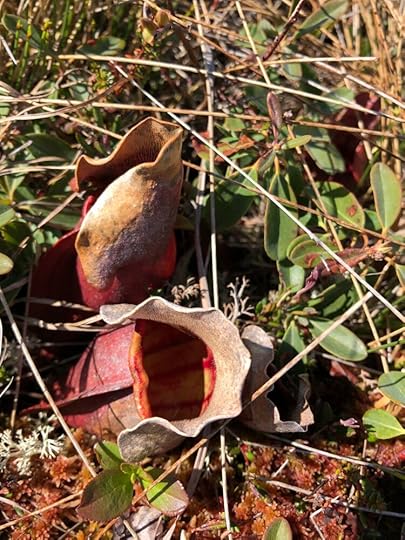
* For more info on historical cabinets of curiosities, check out these articles:
Smithsonian Mag: How Cabinets of Curiosities Laid the Foundation for Modern Museums
Sotheby’s Institute of Art: Cabinets of Curiosities and the Origin of Collecting
Art & Object: The Cabinet of Curiosities & Colonialism
https://www.artandobject.com/news/cabinet-curiosities-colonialism
January 27, 2025
Books Matter. Art Matters. What You Do Matters, Too.
When I was a little girl, bedtime stories were the best part of my day. I’d snuggle up with Mom or Dad in the big green-upholstered armchair for another round of The Digging-est Dog or Stop That Ball (parts of which I can still recite to this day). When I got a little older, I’d lie in my big-girl bed while Mom read a chapter of Little House in the Big Woods or The Hobbit. There’s no doubt in my mind that these early experiences are the reason I’m a writer today.
Reading together gives kids and their grownups common ground: shared knowledge, shared experience, and shared language for navigating tricky conversations. If time to read together is scarce, don’t despair. Some studies have shown that simply having books in the house improves kids’ reading, math, and technological skills.
Books are magic, ya’ll – the best kind of magic there is.
It’s Family Literacy Day today. In a time of organized efforts to restrict access to books — particularly books for children — reading has become an act of resistance. So read together today: fill your brains with ideas and your souls with stories. Knowledge is power, and power is between the pages of books.
On January 2, I flew to California for the first residency of an MFA program in Writing for Children and Young Adults (VCFA/CalArts). We had earthquake safety training on the first day…. and three days later, California caught on fire. I made it home safely, but a lot of people have no homes left to go to.
The world is literally burning, and for a while now, it’s felt like civilization is burning, too. Somedays it’s hard to imagine that anything we do will make a difference. In my case, it feels frivolous to invest in more education when I’m already pretty good at what I do. And it’s easy to wonder whether what I do actually matters to anyone other than me.
When I feel that way, this is what I tell myself:
I write a book, and if I’m lucky, that book gets published.
If I’m very lucky, that book finds its way into children’s hands.
If I’m very, very lucky, I get to meet some of those kids — kids who tell me that my book turned them into readers.
If I’m less lucky, I never meet those kids. But that doesn’t mean they don’t exist.
We can never know the full impact of our own actions, and that goes for the good as well as the bad. So keep doing the best you can, because what you do matters. What you do really does makes a difference.
And so does reading books.
#FamilyLiteracyDay

Me (bottom left) and 10 members of my first-semester MFA cohort. Not pictured: two cloud-based members, and one on-campus member who was busy evacuating from Altadena.
January 5, 2025
Marie Prins: Dawg and Daily Life
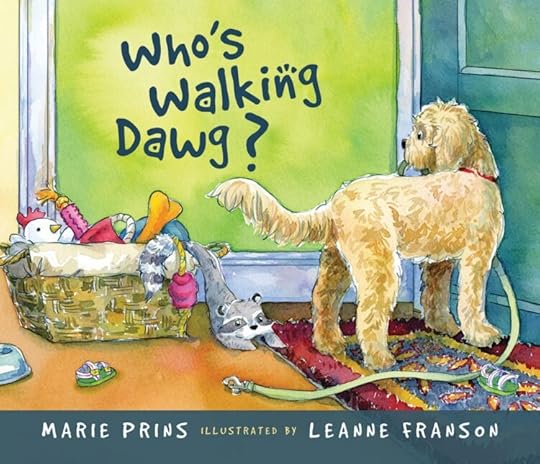 Welcome to Cantastic Authorpalooza, featuring posts by and about great Canadian children’s book creators! Today’s guest:
Marie Prins
. Take it away, Marie!
Welcome to Cantastic Authorpalooza, featuring posts by and about great Canadian children’s book creators! Today’s guest:
Marie Prins
. Take it away, Marie!
I came to writing for children late in life, well after my own children had grown and left home. But books and stories have always been a big part of my life, even before my mother taught me to read at age five. Through childhood and my teens they were a welcome refuge. In university I read piles of them as an English major. As an adult, I sold them in bookstores, and later as a reading tutor, I helped children learn to read them. My frustration with finding phonetic readers lead me to writing children’s stories, but not to crafting a single reader. Instead, inspired in a children’s writing course, I embarked on a decade long journey to write a time-travel, dual narrative middle-grade novel. Before its publication in 2020, I decided to try crafting something shorter, something simpler, something easier, like picture book stories. Hah! Little did I realize I had entered another writing universe! Unsurprisingly, my attempts read like short stories, interesting ones but definitely not picture books. Get your word count down, suggested my critique partners. Drop those adjectives! Make room for the illustrator!
Well, okay, I thought, as my dog nudged my leg for a walk. Let’s try this out on a familiar scenario. What if I was too busy to get that leash? And he nosed the door open? Where would he go? What would he do? Not long after these musings were answered, I had written the first draft of Who’s Walking Dawg?, minus its ending. Of course, Dawg had to return home. Would he or his family change their slightly negligent behaviour? Probably not. Family life is super busy. But parents and children love their pets and do their best to look after their needs. Dawg’s ending with a twist reassures readers that even when the ball is dropped, things work out at the end of the day.
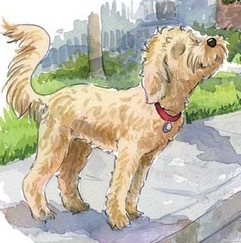 Bev Brenna at Red Deer Press suggested Leanne Franson as the perfect illustrator to bring Dawg to life. Her dog choices are just right! I love Dawg portrayed as a big, energetic pooch who bounces through the pages of his story. After seeing his happy face grinning at me in the initial sketches, I couldn’t think of him any other way, first begging the members of his multi-racial family for a walk and then on the last pages revelling in their love.
Bev Brenna at Red Deer Press suggested Leanne Franson as the perfect illustrator to bring Dawg to life. Her dog choices are just right! I love Dawg portrayed as a big, energetic pooch who bounces through the pages of his story. After seeing his happy face grinning at me in the initial sketches, I couldn’t think of him any other way, first begging the members of his multi-racial family for a walk and then on the last pages revelling in their love.
Who’s Walking Dawg? was released on November 15, 2024 in Canada and will become available in the United States on February 1, 2025.
Marie Prins is a semi-retired remedial reading tutor who lives in a historic house in Colborne, Ontario, close to Lake Ontario, with her husband and just Max the Cat. Her books and other writing can be found on her website www.marieprins.ca and on Instagram @Marie.Prins.
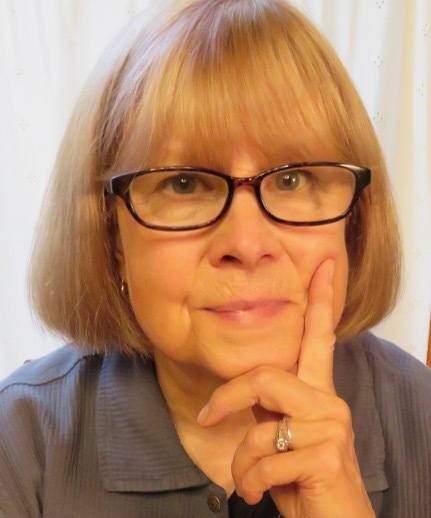
December 18, 2024
That Time I Accidentally Gave Kate McKinnon a Copy of My Book
I’m still freaking out a little bit about not being ready for Halloween, and here we are, with Christmas just around the corner. But I’m pretty sure I’ve nailed the holiday decorating:
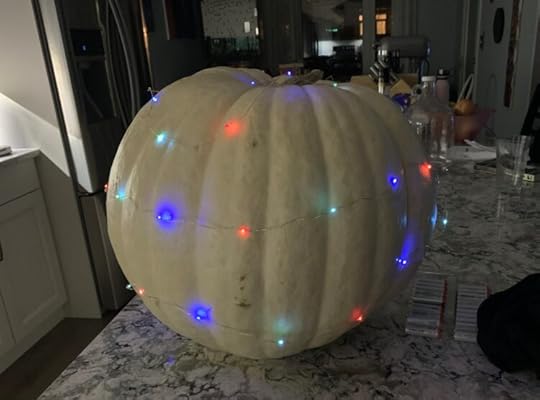
I’m back from a whirlwind trip to Boston, where Tech Support and I took in the sights, and where I – with author-friend Rochelle Strauss and teacher-friend Chris Carlton – presented at the National Council of Teachers of English conference. We had an incredible time, but a few moments stand out:
I’ve always been fascinated by the social, cultural, and historical factors that result in outbreaks of witchcraft accusations, so a side-trip to Salem was mandatory. Modern-day Salem is a very weird vibe of commercialism and pop culture and photo ops layered over a genuine historical tragedy, and I’m still grappling with my feelings on that. But if you’re interested in history, I highly recommend a visit to the Rebecca Nurse Homestead in Danvers – it’s the only remaining site associated with a victim of the witch trials, and the guides are extremely knowledgeable.
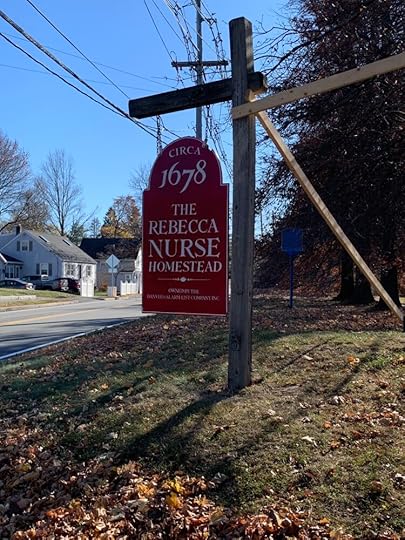
We also took a Murder and Mysteries tour with Witch City Walking Tours, which was much less historical, but still a good time. The tour wrapped up at the Old Burying Point, which (though not visible in this photo) is haunted by the biggest skunk I’ve ever seen. The wildlife biologist in me had a lot of fun watching said skunk doing its thing!

A few days later, we popped over to Cambridge to visit the Harvard Museum of Natural History. During the 19th and early 20th centuries, master glassblowers created more than 1000 scientific models of flowers for the botany department, and the exhibit is just extraordinary!

Glass flowers! I mean, wow!
I also really loved their small-but-thoughtful exhibit on sea monsters in folklore, science, and pop culture. Bonus points for this historical newspaper page, which debunks a sea serpent legend and also features a man telling a woman what not to wear. #LeSigh
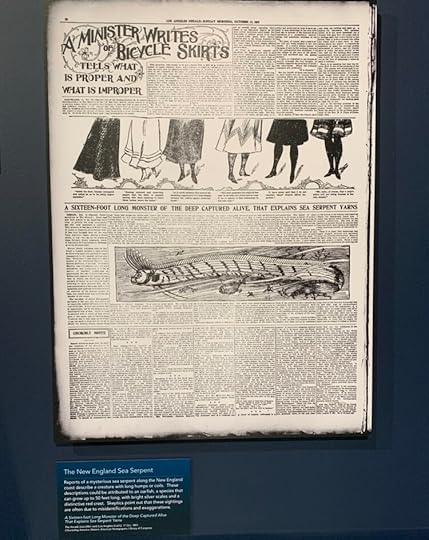
Rochelle joined us for a Politically Incorrect Food Tour of Boston’s North End, which was three hours of great stories and unbelievably good food – in greater quantities than I normally eat in two days. Seriously. The tour ended at 3:30, and none of us ate again until the following day. Which meant we were well-fortified when the madness of the conference began!

Just one of the stops on the food tour – the one with the giant sandwich that none of us managed to finish!
It was my first NCTE, and it was a such a thrill to be surrounded by teachers, and teacher librarians, teachers who train teachers, and teachers who do research into the best ways to teach. To meet teachers championing their students’ freedom to read was truly inspiring. To have teachers recognize my book and tell me how much their kids love it? So incredibly affirming of the work I’ve chosen to do. I’m so grateful I had the opportunity.
And I can’t get over this:
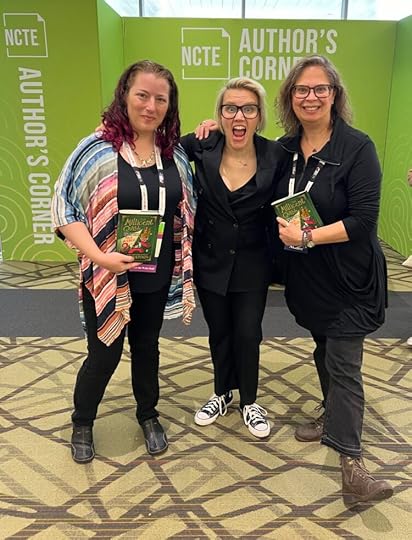
Yup. That’s me, and Rochelle, and Kate McKinnon of Weird Barbie and Ghostbusters fame. During her keynote speech, she talked about her love of science and wanting to give kids permission to go outside and look at bugs. So at her book signing, we introduced ourselves as the science writers who write the books that make the bugs cool. I showed her a copy of POLAR, and she… kept it.
Kate McKinnon has a copy of my book, y’all. Um, what?! And what a way to end 2024!
There are some equally exciting things ahead in 2025. I’ll be rolling out some new blog features and a new email newsletter. And I’ll be starting an MFA in Writing for Children and Young Adults with Vermont College of Fine Arts. My goal – other than to fill the degree gap between my BSc and my PhD! – is to learn how to write young adult fantasy novels.
I’m not giving up nonfiction – my endlessly-curious scientist brain would never permit it! But I am taking the first steps along a new, parallel publishing path, and I can’t wait to find out where it will lead.
In the meantime, wishing you a restorative holiday season and an inspiration-filled new year!
December 6, 2024
Jean Mills: The “Before” that Sparked After the Wallpaper Music
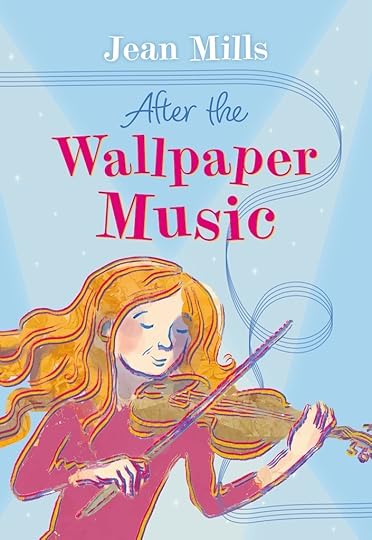 Welcome to Cantastic Authorpalooza, featuring posts by and about great Canadian children’s book creators! Today’s guest: Jean Mills
. Take it away, Jean!
Welcome to Cantastic Authorpalooza, featuring posts by and about great Canadian children’s book creators! Today’s guest: Jean Mills
. Take it away, Jean!
Like most authors, I use the world around me – especially my own world of experience – to create stories for young readers. So it’s not hard to identify the spark that ignited my latest Middle Grade novel, After the Wallpaper Music.
It was my Grade Four recorder group.
Yes, recorder. Sometimes known as the “torture stick”, often ridiculed as an annoying piece of plastic that kids use to torment adult ears. This little instrument changed my life.
We didn’t have any musical instruments in my childhood home, not because they were banned or anything nefarious, but because there were too many other necessities that took priority. I was already a kid with a gift for music, so school provided all my musical experiences, and that worked great. Choirs, school concerts, occasional visiting musicians. Until the recorder!
My Grade Four teacher was a musician, a member of a professional choir, and she was determined to elevate our classroom recorder program. After the prescribed curriculum was done, she rounded up nine of us musically-inclined students and created an extra-curricular ensemble named (not very creatively) The Recorder Group. We split into sopranos, altos and tenors and we learned complicated multi-part compositions from Baroque and Classical repertoire.

My recorder taking a break at the tune session! Credit: Jean Mills
We won ribbons at festivals and played Christmas concerts at Toronto churches. As we progressed through elementary and into middle school we shrunk and became a trio, but the concerts continued. I remember playing a Baroque concerto to a full classroom of music students at Wilfrid Laurier University in Waterloo and hearing the professor say to our teacher, “Some of my students haven’t even heard of Frescobaldi!”
And on one incredible, memorable night, we collaborated with a group of older students from another school and walked on stage at Massey Hall in Toronto to perform in a post-Kiwanis Festival gala concert. I was the one playing the challenging and unwieldy bass recorder, and I was in heaven.
Many musical adventures followed. Piano lessons (finally!), viola in the school orchestra, teaching myself guitar and mountain dulcimer. Performing, teaching, composing. So many special moments and special people.
And it all started with my little recorder.
Flora Parsons, the musical girl in After the Wallpaper Music, is probably me. She plays violin (not recorder) at school and in an ensemble. But her violin does more than that. It becomes a fiddle when she plays traditional Newfoundland tunes for Auntie Flora. It becomes an electric guitar when she plays rock riffs with Simon. Just like my recorder becomes a whistle when I sit down for a Sunday afternoon tune session with my traditional music friends at a pub in Cambridge.
As any musician knows, music has the power to connect, teach and even heal us. Musical magic. I love to imagine where Flora’s musical path will take her…
And what is “wallpaper music”? Something I’ve played many, many times on a variety of instruments. Just another slice of my musical life that made its way into this story!

Singing and playing recorder with my band Greenwood at The Registry Theatre in Kitchener, Ontario

